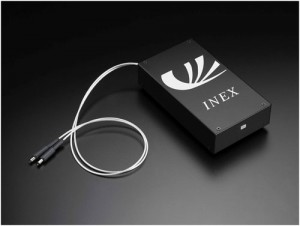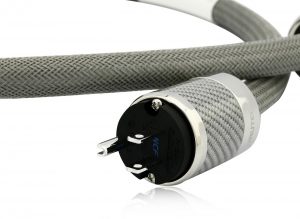It was clear from the very beginning that the Harmonix X-DC Studio Master Million Maestro power cable was a highly limited product, so it was intended for a small group of customers. Its price only this sealed this exclusivity. I envy the lucky ones who have it in their systems—it is the best power cable, I have ever heard. In addition, it perfectly fitted in my understanding of sound—it was not only good, but also synergistic with my system.
In a kind of a "letter" customer receives with his new cable, Mr. Kiuchi makes a clear statement: the Hijiri 聖 SMT Takumi Maestro is intended for experienced music lovers who missed a chance to own X-DC Studio Master Million Maestro. And then - it costs half as much, but the sound it offers does not differ much from that of the "Million". It was prepared according to the (if I understand correctly) Harmonix Tuning Maestro rules, through the use of carefully selected, tested materials, such as custom-made copper conductors. Each cable is hand-made.
The copper conductor is directional. The cables feature cotton braid and are terminated with custom-made plugs by US company WattGate. This custom-make involves, among others, applying wooden barrels on plug's ending that dampen vibration. The wooden element is placed also over the cable along its run. The plugs look very nice—it's 390i Rh model on one side and the 350i Rh on the other, both feature rhodium-plated contacts. The cables are available in of 1, 1.5, 2, 2.5 and 3 m lengths. The cable comes in a beautiful, hand-carved box.
TEST METHOD
The nature of power cables prevents user from head-to-head comparisons as one needs a longer or shorter interval to switch cables. It requires turning the device one uses it with down, unplugging the cord, plugging in another one and then still waiting a moment until the device parameters have stabilized, which is particularly important in the case of tube devices. So in this case listening to longer album fragments, or even entire discs becomes the way to go about such test.
The Hijiri 聖 cable was used with four devices: Ancient AIR V-edition CD Player with a tube output, Audionet Planck CD player with solid-state output, transistor power amplifier Soulution 710 and vacuum tube headphone amplifier Ayon Audio HA-3.
I compared it with three cables I use permanently in my system: Acrolink Mexcel 7N-PC9500, Harmonix X-DC350M2R Improved-Version and Acoustic Revive Power Reference Triple C . It was plugged into Acoustic Revive RTP-4EU power distributor, and the latter featured 2,5m Acrolink Mexcel 7N-PC9500 power cable plugged into dedicated power line via Furutech outlet with rhodium-plated contacts (all cables and power sockets used in the test featured rhodium-plated contacts).
HARMONIX & 聖HIJIRI in HF
- Test: 聖HIJIRI NAGOMI X-DCH - power cable
- Best Sound: 2015: 聖HIJIRI HGP-10R "MILLION" – analogue interconnect, see HERE
- Review: 聖HIJIRI HGP-10R "MILLION" – analogue interconnect, see HERE
- Review: Harmonix TU-666M "BeauTone" MILLION MAESTRO 20th ANNIVERSARY EDITION – anti-vibration feet, see HERE
- Review: Harmonix X-DC STUDIO MASTER MILLION MAESTRO – power cable, see HERE
- Review: Harmonix X-DC350M2R IMPROVED-VERSION – power cable, see HERE (Polish)
- Review: Harmonix RS15-ANV – anti-vibration platform, see HERE (Polish)
- KRAKOW SONIC SOCIETY, meeting #72: KAZUO KIUCHI (Combak Corporation) in Kraków, see HERE (Polish)
- Review: Harmonix HARMONIC-STRINGS HS101-EXQ EXQUISITE + α1 speaker cable + speaker cable stands, see HERE (Polish)
- Review: Harmonix HS-101-GP + HS-101-SLC - interconnect RCA + speaker cable, see HERE
- Review: Reimyo + Harmonix + Bravo! – Combak Corporation audio system, see HERE (Polish)
SOUND
Recordings used for the test (a selection):
- Estampies & Dances Royales, perf. by. Hesperion XXI, cond. by Jordi Savall, Alia Vox AV 9857, SACD/CD (2008)
- John Coltrane, Coltrane. Deluxe Edition, Impulse!/Verve 589 567-2, 2 x CD (1962/2002)
- Laurie Anderson, Homeland, Nonesuch 524055-2, CD + DVD (2010); review HERE
- Nirvana, In Utero, Geffen GED 24536, CD (1993)
- Paula Cole, Courage, Decca B0008292-02, CD (2007)
- Rosemary Clooney, Rosemary Clooney sings Ballads, Concord/Stereo Sound SSCDR-007, "Flat Transfer Series", CD-R (1985/2016)
Mr. Kiuchi's new cable is the result of a reflection on the reproduced sound. Trivial? - A little bit, yes, but it is also the key to understanding what this man is seeking and from which side he climbs an audiophile Mount Everest. I've heard this before with Harmonix and Hijiri 聖 power cables, so this is not a surprise for me. I also experienced what Kiuchi-san is capable of achieving when making cost-no-object product and having sufficient time for a project—the result is so unique cable, as the X-DC Studio Master Million Maestro. This is an approach, in which the most important is the experience, not the technological advancement of the product. This is more of a "listen first, measure later" approach. If the measurements seem off but the sound is right, well to hell with measurements (this comes from me, not Mr Kiuchi).
The power cable under review had even more difficult task. On the one hand it had to be better than—very successful - 聖HIJIRI Nagomi X-DCH, on the other hand it had to preserve as much sound quality as possible of the limited "Million" cable.
One thing you can say about it right away, is related to sound's liquidity. It is a feature of all Mr. Kiuchi's cables, but here it is simply phenomenal. The sound is deep, dense, with pitch black background. It presents instruments and vocals in a very natural way, without emphasizing the elements that "tune up" the sound. These are cool, usually very likable, but ultimately it is about as high fidelity towards the recorded material as possible, right? With that Takumi has no trouble being in this respect better than the Acoustic Revive Power Reference Triple-C and at least as good as Acrolink Mexcel 7N-PC9500, if not better.
In terms of tone and three-dimensionality it comes close to other Combak Corporation cables, especially to X-DC350M2R-Improved Version and "Million". So there is this naturally soft attack and smoothness. You can not hear any harshness, because there is none, neither can you point out any signs of coloration, because again, there is none. From the first to the last album I listened to, I witnessed an extremely well balanced sound. Moreover, the cable beautifully presents the differences in tone, in instruments placement, as well as dynamic range. In this respect it is superior to Harmonix X-DC350M2R and the Acoustic Revive. And from Hijiri Nagomi X-DCH, too.
In the Nirvana's Rape Me track first comes a guitar and voice, relatively little compressed, and immediately after them enter the drums and bass, that are withdrawn compared to the voice and highly compressed, the reviewed cable delivers it very clearly. It does not try to hide anything. But it is, however, still Mr. Kiuchi's cable and as such, it avoids being literal. In this respect, Acoustic Revive seems to render everything using thicker lines, it emphasizes treble bit more and delivers slightly tighter bass. Takumi focuses bit lower in the middle of the band and this range is incredibly natural, very three-dimensional, it's even better in this regard than my reference, Acrolink. Only "Million" did even more in this respect, adding even more saturation and delivering even more palpable "body" of the sound. In this comparison the reviewed cable appears to be slightly softer, but not much—the yellow-black X-DC350M2R is even smoother.
What I find especially convincing about this cable is a combination of natural sound and differentiation, that has already been mentioned. Only handful of cables copes so well in this regard, primarily Million, but also Acrolink. The latter is darker, offers less treble, so that it appears more vivid. In fact it is not, but the impression remains. Only after longer listening Acrolink turns out to be not so illuminated internally, is also not so dynamic as Takumi.
The new cable offered vividness, fluidity, saturation and differentiation—a deadly combination. After such a performance one does even want to listen to other cables. Acrolink still has some features that make it one of the best proposals in the market—for example—an absolute smoothness, that with Takumi is not quite as fabulous, better defined lower bass, which at the same time goes even deeper; Takumi stops a little higher. As far as one listens to acoustic music, such as jazz and classical, it has no meaning. One can hear it only when listening to electronic music.
I have to say, however, that knowing all this about this cable, it didn't bother me at all. It worked perfectly especially with my CD player, and before that its also brilliantly supported the Audionet Planck, and what it did with the power amplifier Soulution 710 was also of a very high level, even though it replaced there the Acrolink cable, that tempered this amplifier's tonal balance, moving it slightly down the band.
Ultimately it counts how the component sounds during long listening sessions, without direct comparisons. And here Takumi is hard to beat, as it is a fantastic match for a variety of devices and music genres. It does not try to improve recordings, as I heard it with Acoustic Revive on one hand, that added more power to the attack and changed tonal balance emphasizing both range extremes, pushing them forward, nor smoothed treble up as the Acrolink did. It delivers music in a very honest way, never forgetting about its emotional layer.
Summary
"Not forgetting" is an understatement—emotions are in its performance, the most important element of music and Takumi seems to specialize in conveying them. It's a combination that is very versatile. It is a cable that will improve nothing in the system, neither will it degrade anything. It will allow recordings to sound in an emotional, naturally soft, full-bodied way. Even in those, that were not "tuned-up" during remastering, it finds lots of music and shows listener why analog master tapes are so amazing.
Just listen to a special edition of the Rosemary Clooney Sings Ballads album of the Flat Transfer Series. It's a copy of the master tape copied without any sort of interference directly to a CD-R, which was commissioned by the Japanese magazine Stereo Sound (in Japan). The album contains only two songs. Takumi delivered a credible presentation with proper internal drama intensity. It was a beautiful experience and so I know what Santa will bring me this year 🙂 And the cable itself, right now, receives the RED Fingerprint.
Uwaga: RED Fingerprint
Hijiri 聖 SMT 'Takumi' Maestro AC Cable
Price (in Poland):
19 900 PLN/1 m | 21 990 PLN/1,5 m | 25 990 PLN/2 m
Combak Corporation
Kazuo Kiuchi ǀ 4-20, Ikego 2-chome, Zushi-shi
Kanagawa 249-0003 ǀ Japan
MADE IN JAPAN
Provided for test by: MOJE AUDIO
Text: Wojciech Pacuła
Images: Wojciech Pacuła |
Translation: Marek Dyba















































